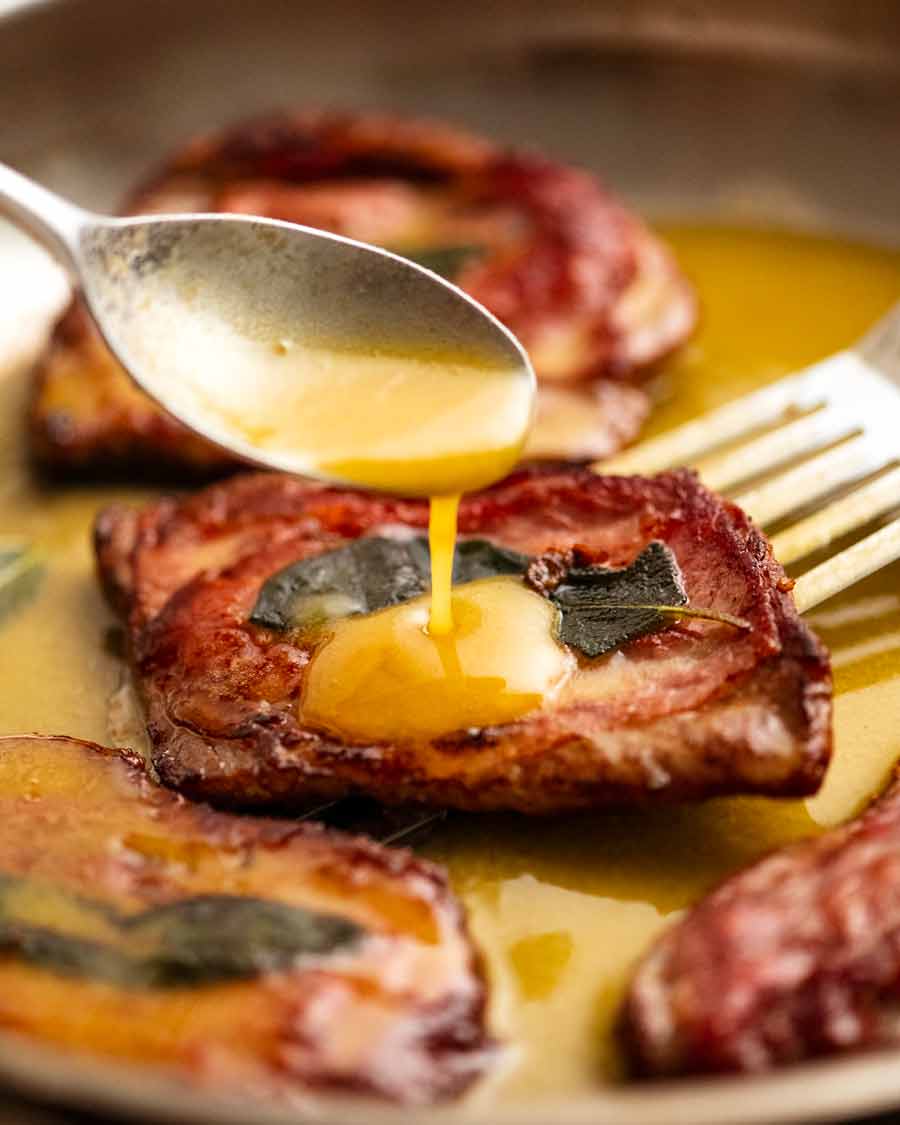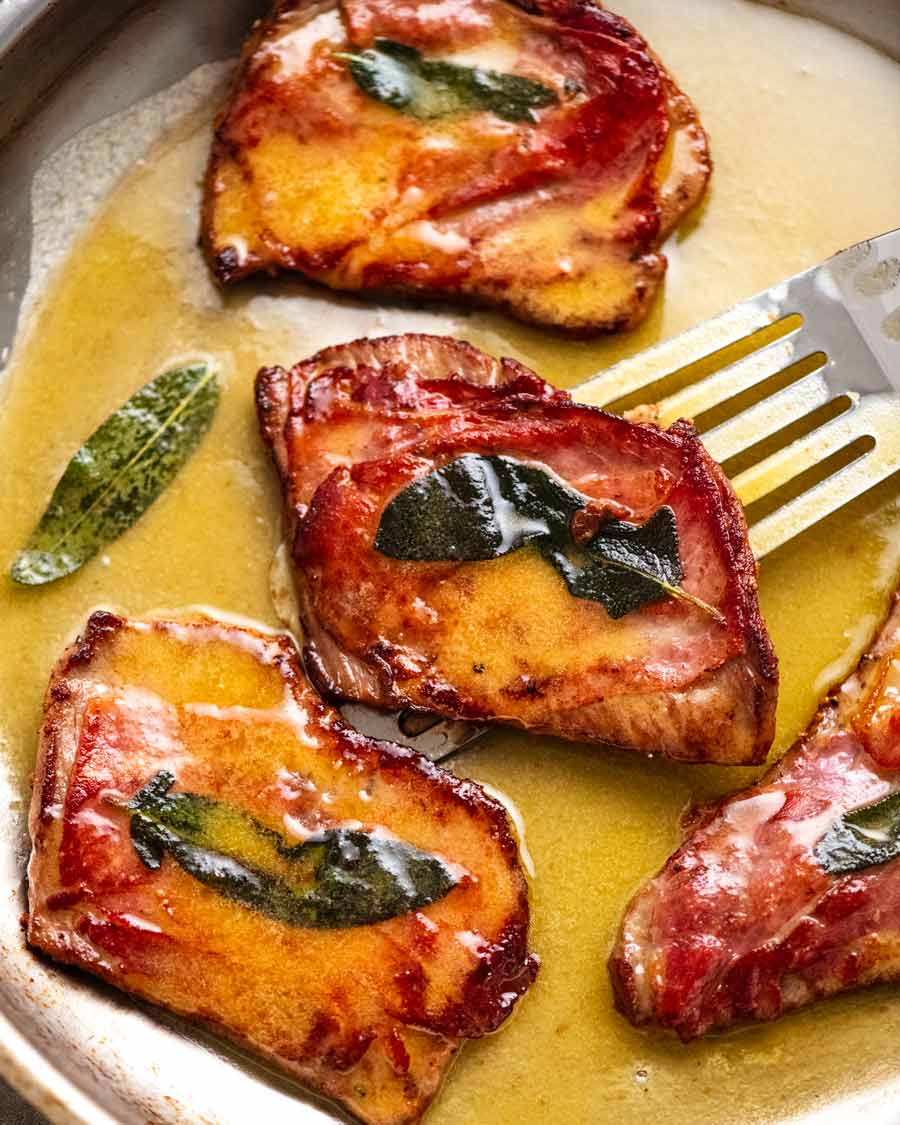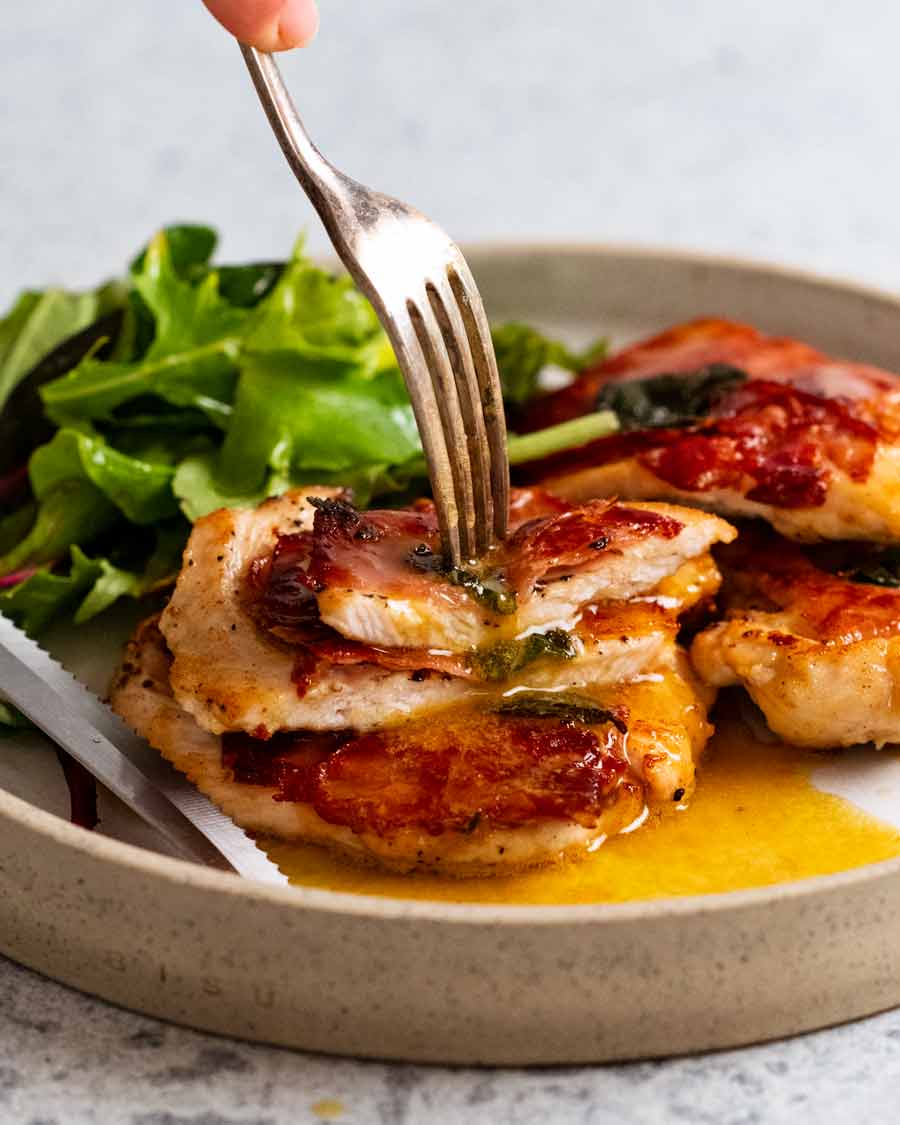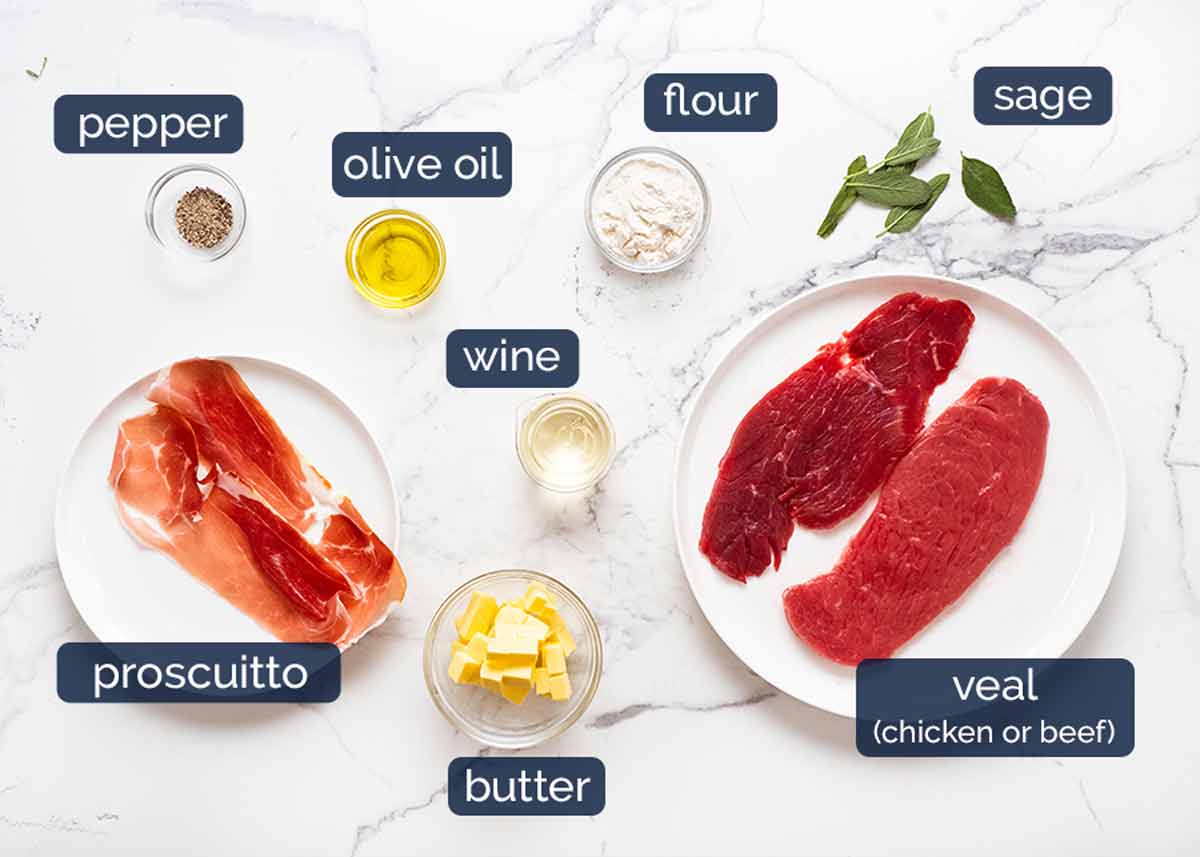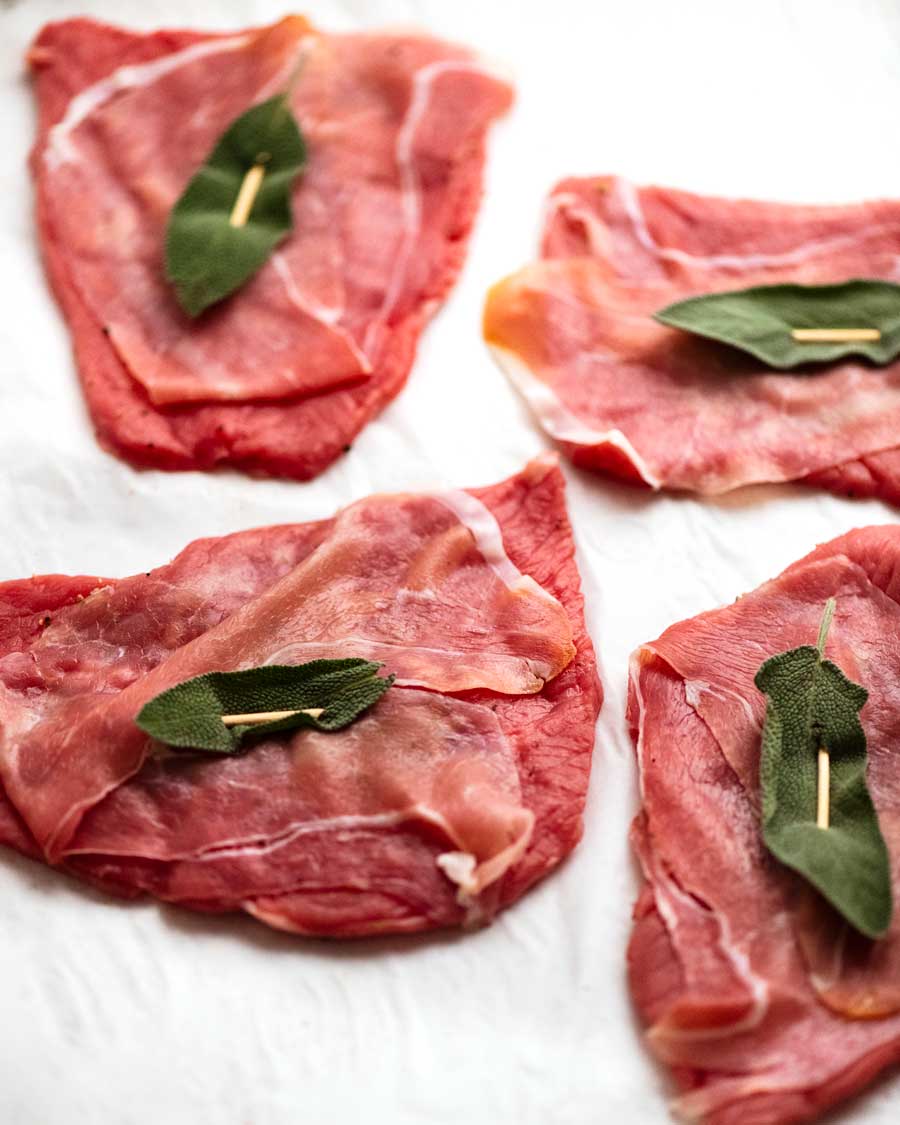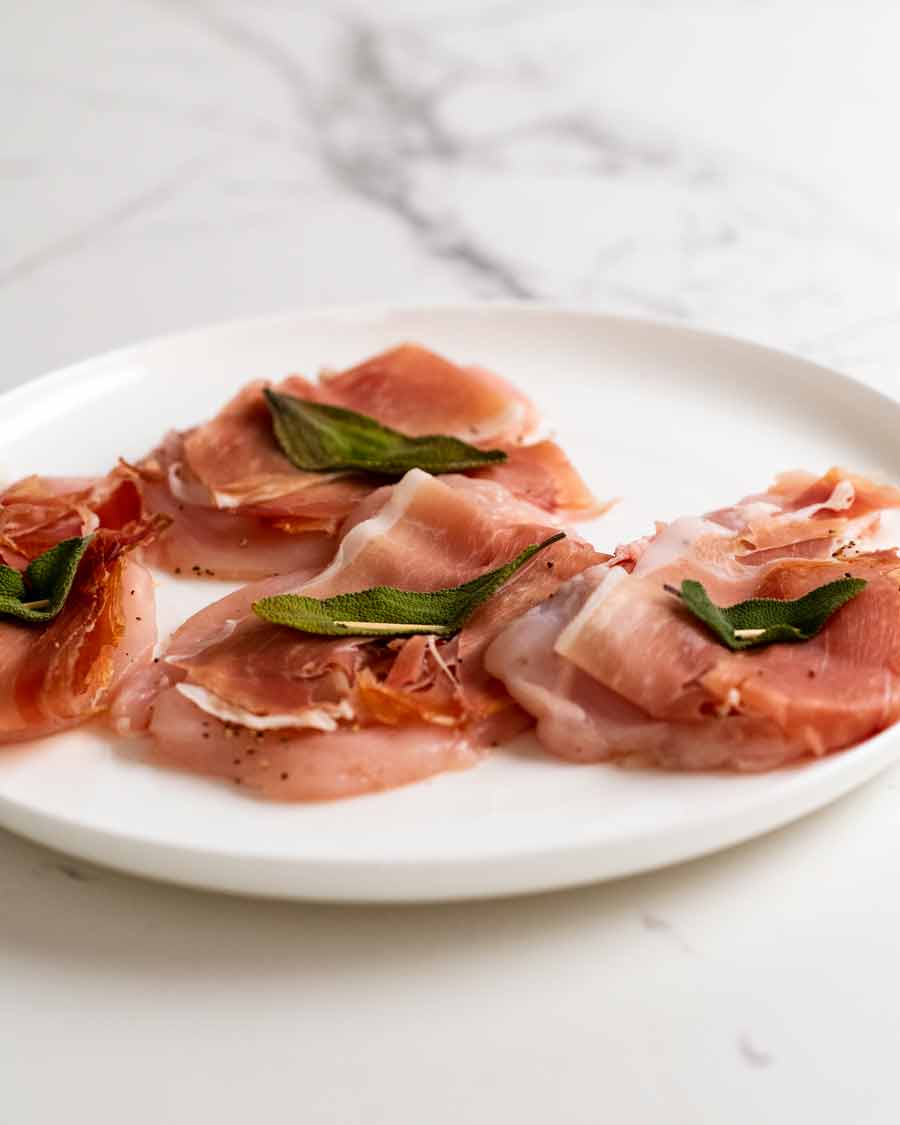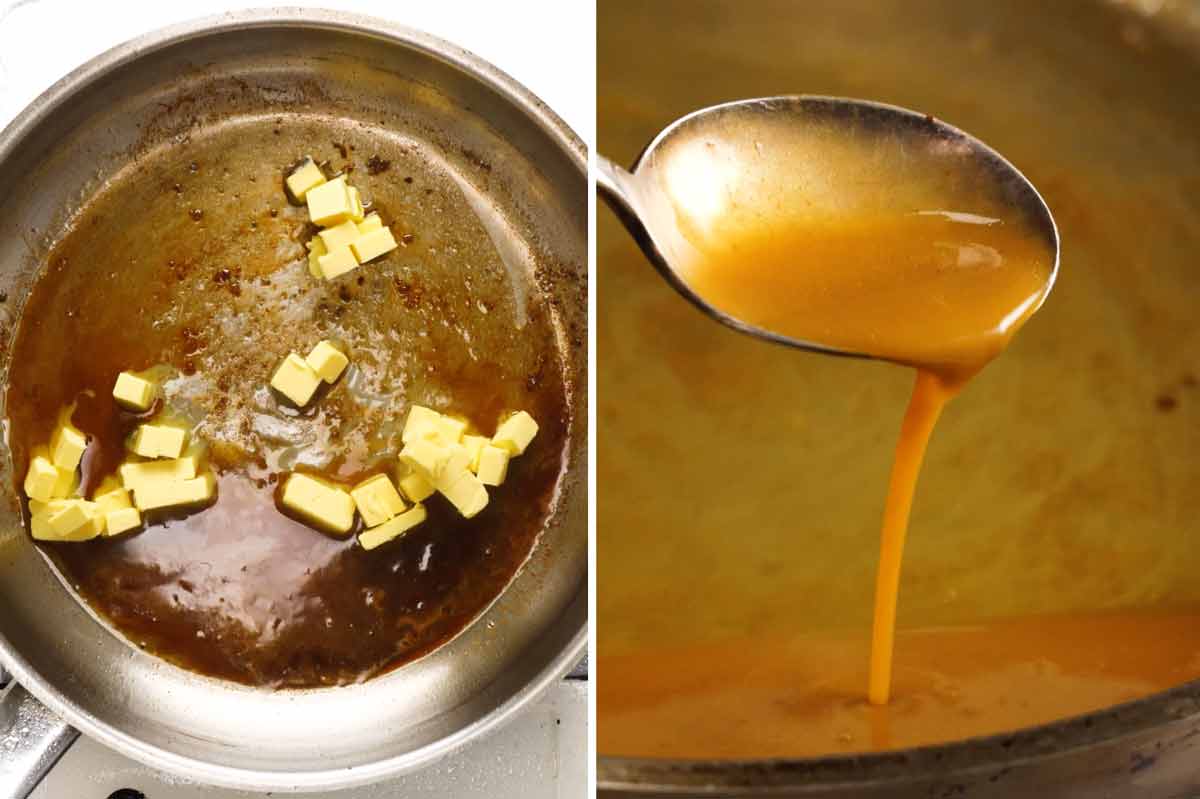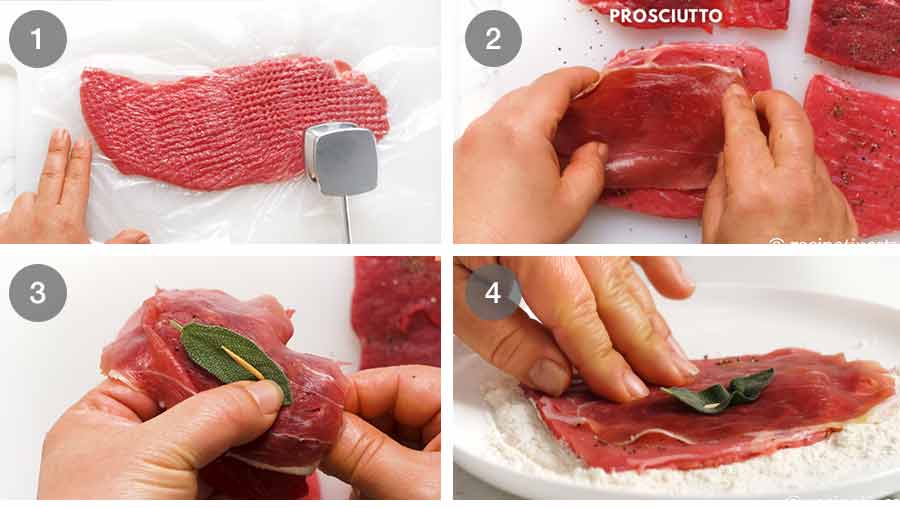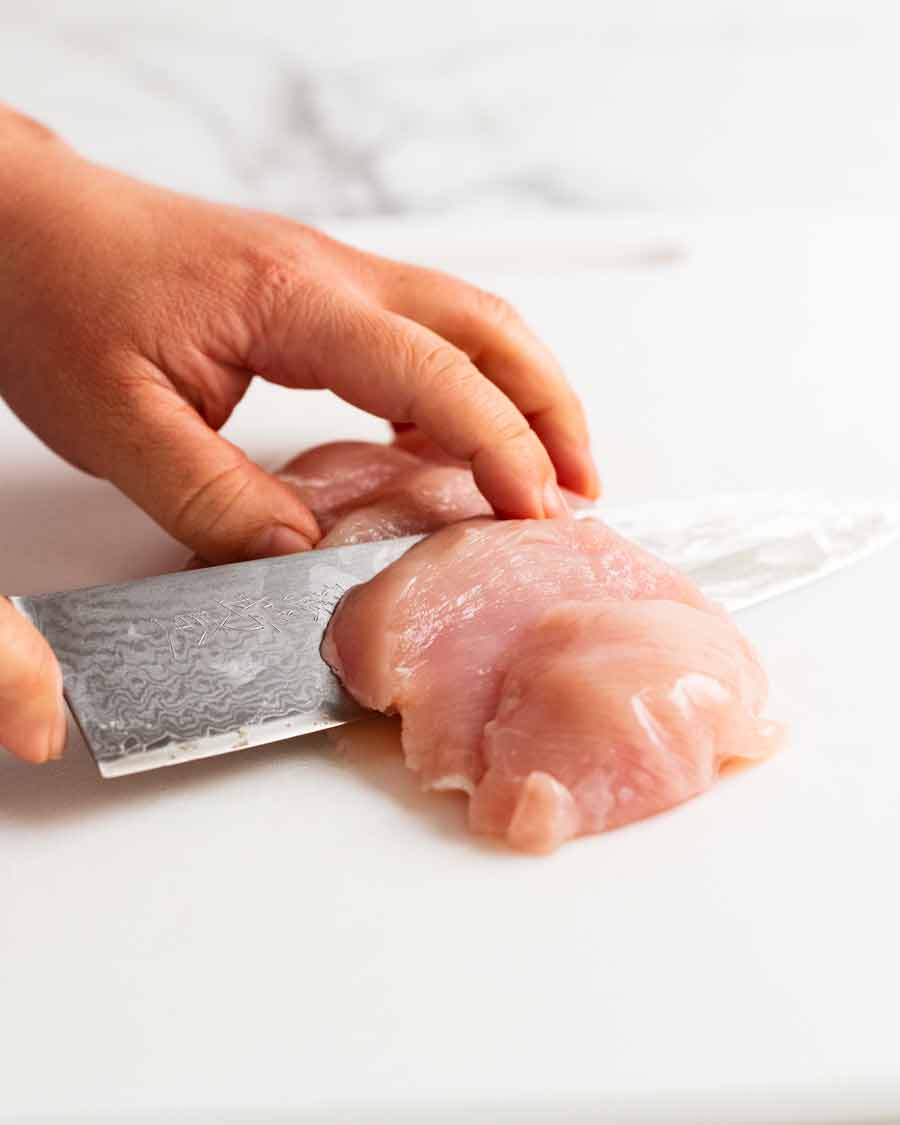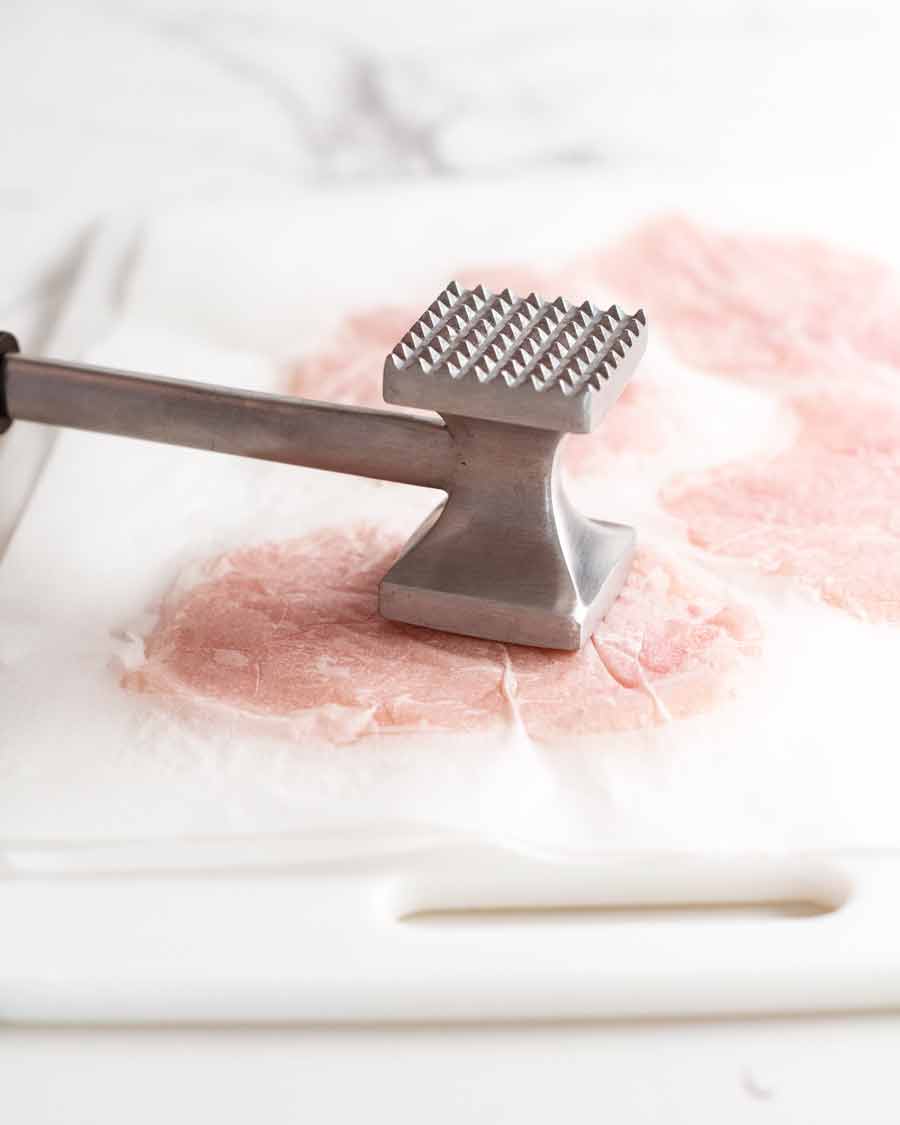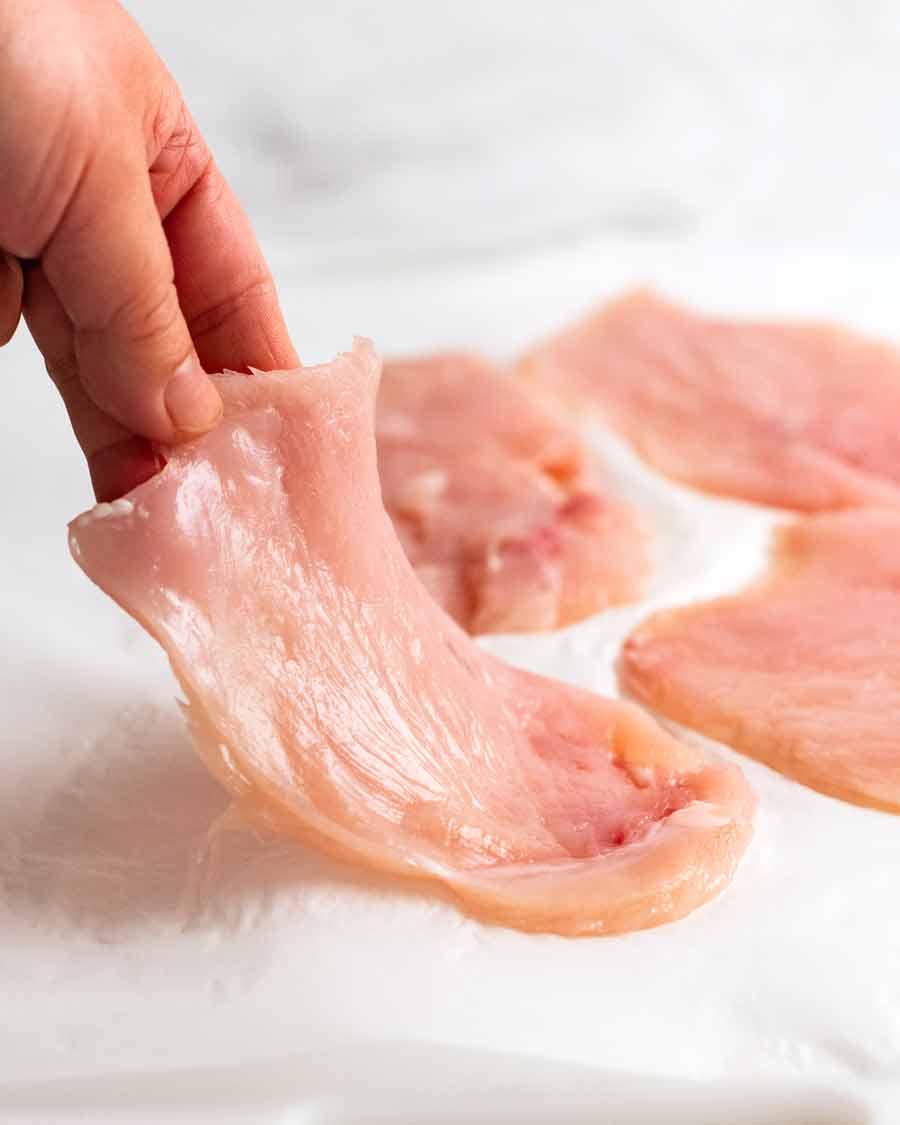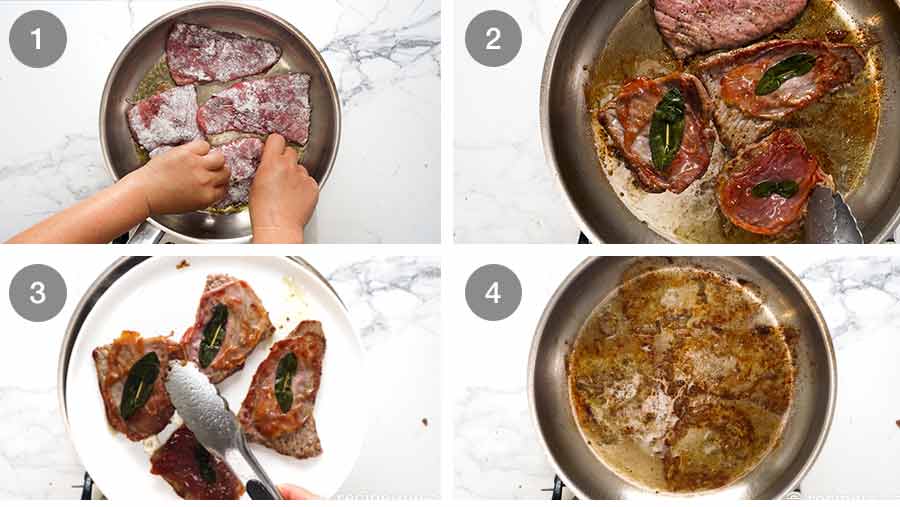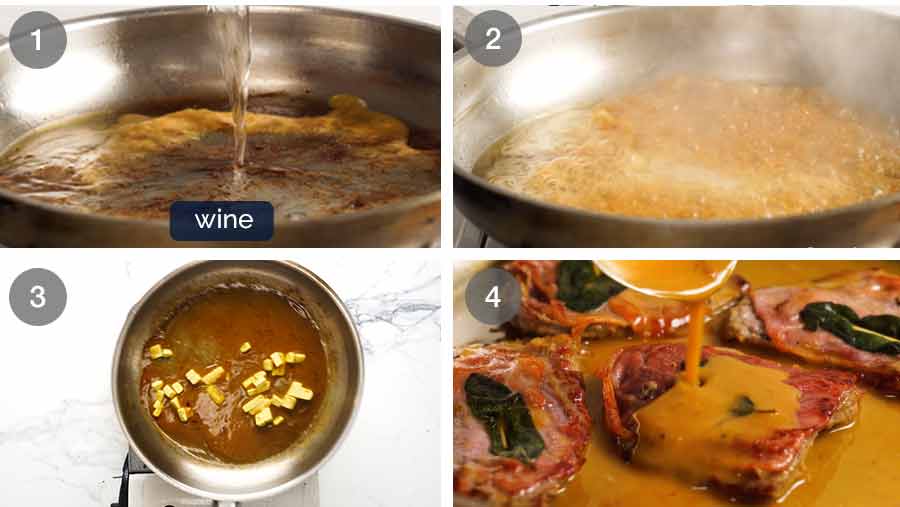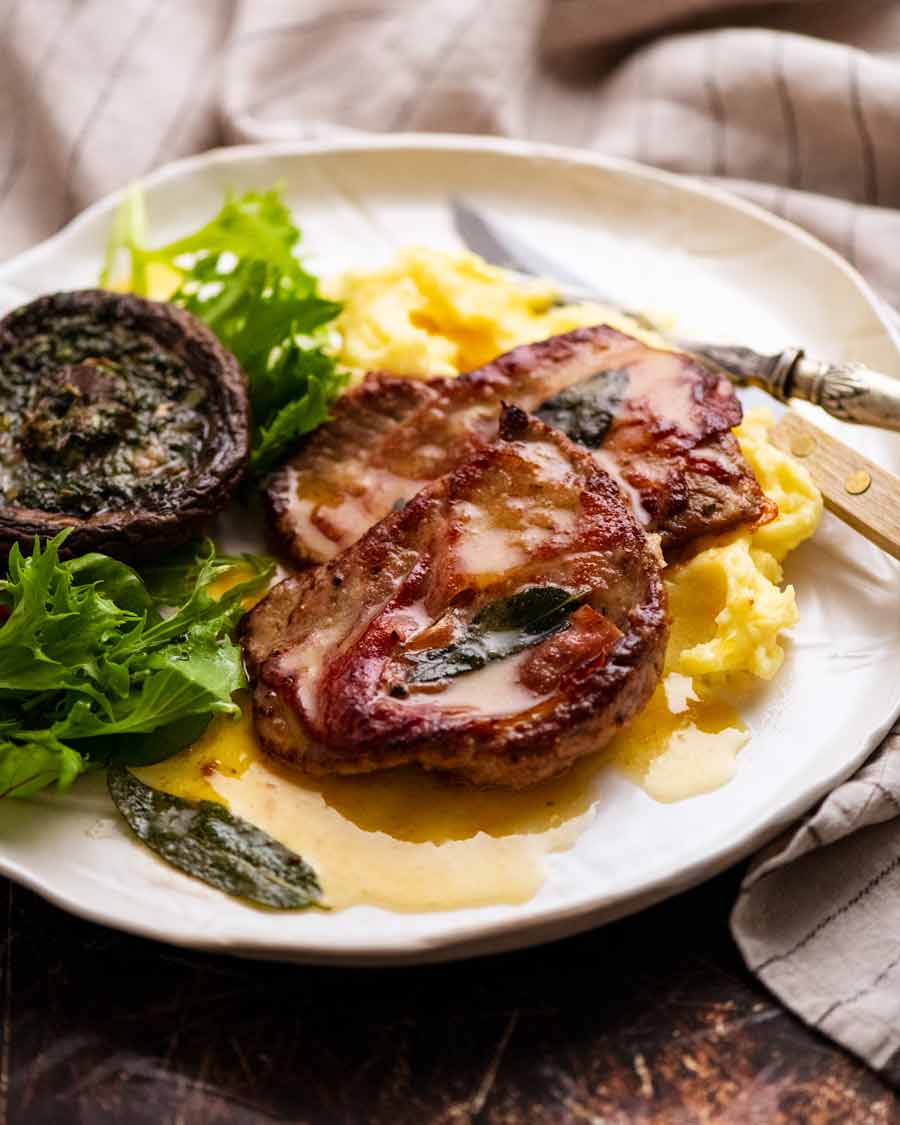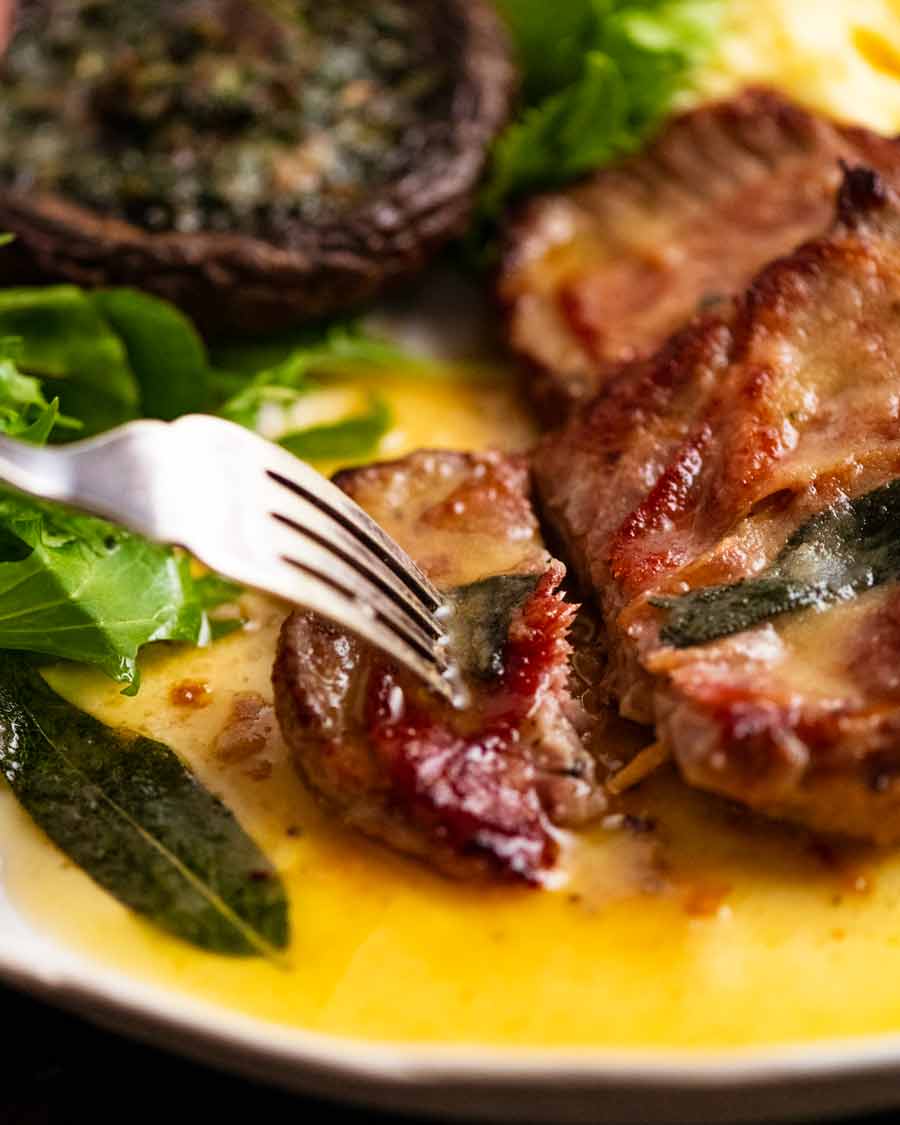HOT TIP: Great dinner party / make-ahead recipe. Keep it prepped in the fridge, then it’s just a 3 1/2-minute cook (including the sauce!).
Saltimbocca
The literal translation of Saltimbocca is “to jump in your mouth” which is probably in reference to the flavour that hits your palate on first bite. But also, perhaps, about the speed at which it can be made. As in: So fast, it jumps in your mouth. You see what I did there??! 😂 A classic Italian dish originating from Rome, Saltimbocca is traditionally made with thin veal cutlets wrapped or topped with prosciutto, and a whole sage leaf often pressed or pinned on top with a toothpick. Pan-frying turns the prosciutto golden and the meat inside is so thin, it literally takes 2 1/2 minutes flat to cook. Then the buttery, silky white wine sauce is made in the same pan – this takes just another minute! It’s simple, classic, rustic and fabulous. A cursory browse of internet recipes show some rather eyebrow-raising takes on Saltimbocca – rolled versions, skewered versions and versions smothered in cheese that look suspiciously like Parmigiana. Whereas actually true Saltimbocca is far simpler. After all, why mess with perfection?
Veal, beef, pork or chicken Saltimbocca
As mentioned earlier, Saltimbocca is traditionally made with veal. However it works just as well with chicken, pork or beef, which for many people is easier to get and cheaper. Veal vs beef Saltimbocca – I’ve tried both and here are the differences. Veal is a more delicate, tender version of beef – with a lighter flavour and a more giving texture. Beef, once pounded into thin steaks suitable for saltimbocca, is still more tender than a thick-cut steak but not as soft as veal. That’s not to say that veal tastes better than beef in my view. They are just different! And different again is using pork or chicken for saltimbocca. Both mighty delicious, I should add! The chicken saltimbocca pictured below was lunch yesterday. I snapped a quick photo then hoovered it down still warm!
Ingredients in Saltimbocca
Here’s what you need to make traditional Italian Saltimbocca: Saltimbocca is unexpectedly economical, calling for just 80g / 2.5 oz protein and 2 small slices of prosciutto per serve.
Veal (or chicken or beef) – Whatever your protein of choice, it needs to be in a thin piece of meat! It’s handy if you can buy them as already thinly sliced steaks (sometimes sold as “sizzle steaks”, “scallopini” or “schnitzel” here in Australia) so they only require a light pounding out. Otherwise, you can slice meat yourself and then flatten the steaks out. Here in Australia, veal steaks in particular are always sold thin, rather than thick-cut like beef steaks.If you’re preparing your own Saltimbocca meat, just make sure you are using a cut of meat that is suitable for quick-cooking like steaks. Tougher cuts that require slow cooking to make them tender such as chuck, ribs, belly and shoulder (ie cuts you use for stews and casseroles) are not suitable.Chicken – Use a whole breast, sliced into steaks and pounded out. See step photos below for more guidance (I promise it’s easy, and it doesn’t need to be perfect, just cook-able). Prosciutto – This is what makes Saltimbocca, well, Saltimbocca rather than a plain ol’ pan-fried piece of meat! Prosciutto is also provides the main seasoning for this dish. We only add the tiniest pinch of salt in the sauce, and none on the veal!How much prosciutto you need – 4 small pieces or 2 very large slices. Enough to cover one side of the veal when folded over itself as a double layer of prosciutto. The underside is not covered in prosciutto (it can be made wrapped all around but I prefer not). Fresh sage – The essential herb in Saltimbocca, sage pairs beautifully with the prosciutto and meat. It also brings a pop of colour. I love how it crisps up as it fries!
White wine – A splash of wine is the secret to make a really tasty pan sauce without fussing with lots of ingredients. The wine is reduced to evaporate most of the alcohol, leaving behind just flavour. So it doesn’t taste winey at all.Wine type – Pinot grigio, being a wine variety popular in Italy, is fitting. However I personally also like chardonnay for the assertive flavours this wine brings to food.Actually any white wine will work fine here, and even a sparkling wine/champagne. Marsala is a fortified wine that is sometimes also traditionally used in Saltimbocca in Italy, but note it is quite sweet and strongly flavoured – so use less.Non-alcoholic sub: I think non-alcoholic white wine would be the best alternative here, followed low-sodium chicken stock/broth (be sure to use low-salt else the dish may end up a tad too salty). COLD butter – Butter is how you transform a watery liquid into a silky, lightly viscous sauce without using any thickening agent like flour or cornflour/cornstarch, properly called “mounting a sauce” in classical cookery. The butter must be cold in order for it to work properly, cut into cubes so it melts evenly and slowly into the sauce. Watch the sauce magic happen in the recipe video below.
Flour – This is used to dust the non-prosciutto side of the veal. Once cooked, it creates a thin crust that gives the sauce something to cling to. Without it, the sauce just slips off the surface of the meat like Teflon. It also helps make the veal or other protein get a little colour on it in the very short cook time. Pepper only – No salt required! The salt from the prosciutto is all we need on the veal. Although I do like to add a pinch into the sauce, it barely needs it. Olive oil – For pan-frying the veal.
How to make Saltimbocca
As I re-read this post, it dawned on me that I included a fair amount of step photos for a recipe that I assured you is so fast and easy! It’s really not hard, I promise. I just thought perhaps assembling the Saltimbocca might be new to some readers so I wanted to show it step by step. If you’re preparing your own Saltimbocca meat, just make sure you are using a cut of meat that is suitable for quick-cooking like steaks. Tougher cuts that require slow cooking to make them tender such as chuck, ribs, belly and shoulder (ie cuts you use for stews and casseroles) are not suitable. Chicken – Use a whole breast, sliced into steaks and pounded out. See step photos below for more guidance (I promise it’s easy, and it doesn’t need to be perfect, just cook-able). How much prosciutto you need – 4 small pieces or 2 very large slices. Enough to cover one side of the veal when folded over itself as a double layer of prosciutto. The underside is not covered in prosciutto (it can be made wrapped all around but I prefer not). Wine type – Pinot grigio, being a wine variety popular in Italy, is fitting. However I personally also like chardonnay for the assertive flavours this wine brings to food. Actually any white wine will work fine here, and even a sparkling wine/champagne. Marsala is a fortified wine that is sometimes also traditionally used in Saltimbocca in Italy, but note it is quite sweet and strongly flavoured – so use less. Non-alcoholic sub: I think non-alcoholic white wine would be the best alternative here, followed low-sodium chicken stock/broth (be sure to use low-salt else the dish may end up a tad too salty). If you’re an old hand at Saltimbocca however, you can bypass this whole section. Here’s all you need to know right here:
1. Assemble the saltimbocca
You can make short work of the prep if you purchase ready-to-cook thin slices of veal, which is how they are typically sold here in Australia. Chicken and beef are also often sold in thinly-sliced form here.
- Go-Between is a plastic sheet that comes in rolls, which you tear off to size like cling wrap. It’s used to protect delicate meats when pounding, and also to put between layers of things to stop them from sticking (hence the name!) It’s especially useful for freezing things. Best way to pound meat: Place the veal between 2 freezer bags, baking paper (parchment paper) or purpose-made plastic sheets called “Go-Between*” (pictured, see below) to protect the meat. Then use a meat mallet or rolling pin to pound the veal gently and evenly so it flattens uniformly. I use the toothed face of the meat mallet for red meat (veal and beef), and the smooth face for chicken, which is more delicate. Cutting chicken for saltimbocca – see info box below for detailed steps.
2. Cooking Saltimbocca
3. Saltimbocca sauce
The pan sauce takes 1 minute flat to make: 30 seconds to reduce the wine then 30 seconds to swirl cold butter cubes in until they melt to create a silky sauce. Boneless thighs are another option if you prefer. Use 2 small thighs. Cut open and spread (butterfly) the thicker end to even out the thickness, then pound. And with that, we’re done! Super fast, see? It HAS to be, or else you’ll overcook the veal. Time to plate up: put the Saltimbocca on serving plates then spoon over that dreamy sauce. Note on sauce colour: The final colour of your sauce will be affected by the amount of fond in the pan. More fond = browner or more orange-coloured sauce (like in the video). Less fond = more butter-yellow sauce, like in the photos in this post.
What to serve with Saltimbocca
Starchy vehicle – I always serve Saltimbocca over a starchy base suitable for maximising enjoyment of the sauce. Which means creamy mashed potato on normal days, cauliflower mash on “I’m trying to be good!” days, polenta on “I’m really going for a proper Italian vibe here!” days, and bread for plate-mopping on “I can’t even handle making mash today!” days. Side salad – Try a side of Sautéed Garlic Green Beans, my favourite Tomato Salad. Or if speed is of the essence, a quick Italian Rocket/Arugula Salad. For something a little special and different, like if you’re serving Saltimbocca for a dinner party, this Bitterleaf Orange Salad or a big Panzanella are options that will turn heads! More ideas in my vegetable sides section – you can browse by vegetable type which my friends tell me they find quite handy. I’d love to know what you serve Saltimbocca with if you give this a go, let me know! – Nagi x
Watch how to make it
Life of Dozer
Rugs are for humans to enjoy looking at and walk on with bare feet. Kleenex’s are to wipe eye-snot and unidentifiable goop coming out of one’s nose. One and the same to him.
